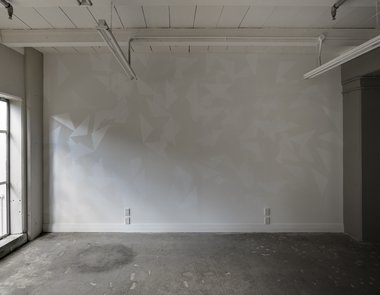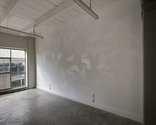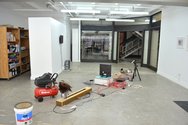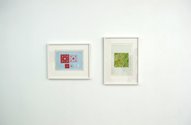John Hurrell – 9 November, 2012
Jeena Shin's wall sized white painting is in three stages, each layer a different glossy sheen applied during closing hours. The chronological separation of reflective varnish mixed with pigment alters the resulting tone as much as any addition of very pale grey might do - the combination affecting her angular configurations according to the position of the viewer and the light coming in the window in relation to the three sheens.
Auckland
Richard Killeen, Simon Ingram, Jeena Shin, Sean Kerr, Martin Thompson, John F. Simon Jr
Procedure
Curated by Simon Bowerbank
26 October - 10 November 2012
Exhibitions investigating art practices of what can include process art, systems art, or ABC art have been with us since the sixties when there developped an impulse to deconstruct subjectivity and ‘creative’ spontaneity to explore the machinelike aspects of human behaviour, the programmatic.
In recent years there has been much renewed interest in the thinking of that period. Overseas there have been group shows like Tate Modern’s Open Systems: Rethinking Art c.1970 (2005) and MOCA’s Afterimage: Drawing Through Process (1999), while in New Zealand exhibitions that touched on crucial aspects include Dirty Pixels (2002), Action Replay: Post-Script (1998) and much earlier, The Grid: Lattice and Network (1983). Some of the ‘procedural’ artists here were included in those.
For this RM exhibition two are making additive wall paintings that incorporate changes over the show’s duration. Simon Ingram’s programmed device seems to replicate human thinking patterns. It is continuously adding more dribbly lines during opening hours, his Lego ‘robot’ slowly making sweeping blue strokes and daubed bars, moving around on rails according to programmed algorithms. In the centre are sheets of card in a L-shaped formation, and these are changed daily, being transmuted to become portable paintings that are ‘creative’ records for the artist to analyse later on, ‘transcripts’ of the machine’s behaviour to scrutinised at leisure. Each day the image starts off like a casually delineated, quite spirited drawing but then becomes denser, darker, heavier, less graphic and less diffuse.
Jeena Shin’s wall sized white painting is in three stages, each layer a different glossy sheen applied during closing hours. The chronological separation of reflective varnish mixed with pigment alters the resulting tone as much as any addition of very pale grey might do - the combination affecting her angular configurations according to the position of the viewer and the light coming in the window in relation to the three sheens. The scattered geometries are thus suspended in space while being locked together, the unstable light direction revealing how new shapes have been placed over adjacent ones from an earlier duration.
Sean Kerr’s sprawling floorbased configuration of solitary light bulb, bashed (loudly amplified) metal bowl and sprinting wig on stick is a regularly structured (but brief) programmed sequence of events that seems to occur in an unpredictable fashion. Once started it follows a set pattern but that beginning can never be anticipated - the periods of inactivity appear to be irregular (we can’t be sure) - and so each start is loud and alarming. Because a compressor - for the streaking hairpiece - constantly needs recharging Kerr manipulates a nonauthorial human component (gallery assistant) to participate within his sequential chain.
Martin Thompson’s red inked drawings on graph paper show symmetrical and extremely intricate patterns that illustrate formulae that very precisely prevent certain minute squares from being touched by colour. Where mistakes have occurred within Thompson’s seemingly compulsive ‘mechanical’ process, repairs have taken place with Sellotape and cut out sections of paper, leaving holes that undermine the fastidious obsessiveness. Test marks for kickstarting the rendering process are also found on the upper edges.
Richard Killeen’s drawing visually links Jeena Shin’s geometry with Martin Thompson’s materials. This 1974 work is part of a series of experimental works that eventually assisted his transition from canvas grid paintings to the aluminium cut-outs, by revealing for him a dead end and allowing him to hand over compositional (image placement) responsibilities to the work’s installer. He has used a formula involving straight lines and mirroring angles to create crystalline, mainly diamond shapes - in mixed orientations - clustered together in a square formation, drawn on graph paper and blocked in with a pale green wash. This period of Killeen’s history is rarely talked about, making this unusual work one of the highlights of this show.
John F. Simon Jr’s contribution is a piece of software first designed in 1997 to demonstrate all possible permutations of black squares filling in a white gridded field at the extraordinary rate of a hundred a second, yet because its mathematical immensity, still taking thousands of years. The version provided for Procedure has six modules that vary between 4 x 4 and 128 x 128, and four modes, one of which starts from scratch, another showing where it is now (the progress since 1997), a third sampling several thousands of years ahead and a fourth abandoning the dominant methodology of sequential series to incorporate random order. I personally like the optical illusion of speeding black over white squares sometimes making not grey blurs but brown - some peculiar retinal or technological aberration.
There is a lot to absorb visually here with these six artists. However a major shortcoming of this exhibition is that Bowerbank’s catalogue with full essay is not available for the visiting public during the show’s duration. In my view this occurrence (commonplace alas in our art scene) is unfortunate, for by itself with no show at hand to directly experience, a late publication is ineffectual. Remembered and documented images don’t cut it, for absorbed conceptual detail needs to be confirmed by the experiential, with direct sensation and analysis of formulae co-existing. A bodily encountering of all the works simultaneously - while pondering in depth procedural explanations - is essential to make the works’ content clear. Especially for this of all shows.
John Hurrell







 Advertising in this column
Advertising in this column Two Rooms presents a program of residencies and projects
Two Rooms presents a program of residencies and projects



This Discussion has 0 comments.
Comment
Participate
Register to Participate.
Sign in
Sign in to an existing account.